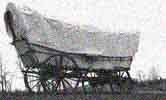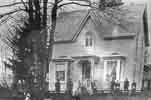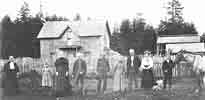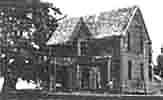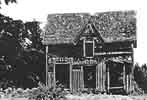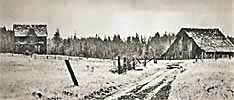Sapling or seed - how did the
Butternut tree arrive in Tumwater?
Here are
excerpts from the University of Washington
Master's Thesis by Paul Thomas in 1965...
They arrived on
the Sound in November 1845, bringing them only
those few belongings which they could tie on
the pack animals...
Just as the
overall picture of agriculture in the Oregon
Territory in 1850 was good, so was life on the
Bush farm, which saw expanded cultivation,
more crops, and larger harvests... There was always
plenty in the Bush household. Wheat and
oats were the principal grains on the farm.
George and Isabella had brought with
them the seeds of various fruit
trees, which were now beginning to bear fruit.
The storehouse was filled with different
fruits and vegetables, such as apples, pears,
potatoes, cabbage, and turnips...
Another view by
Iris White Heikell in her book
"The
Wind-Breaker - George Washington Bush: Black
Pioneer of the Northwest"
...Before
leaving Fort Vancouver , George made his last
visit to Dr. McLoughlin, thanking him for
allowing him to plant trees there and to bid
him farewell.
"Oh, we will
see you again, George," the white-haired
patriarch had said, "When you get those seedlings
started you will be back for your scions,
that I know. I wish you well in your new
home on the Sound, and I feel confident you
will be a credit to your country whichever one
it might be.
A view
by Georgiana Blankenship in her fine old 1914
book "Early History of Thurston County
Washington Together With Biographies and
Reminiscences of Those Identified with Pioneer
Days"
....Mr. Bush,
shortly after his arrival, set out fruit and
shade trees, the seeds
of which he had brought with him from his old
home. Many of these trees grew and
flourished and stand to this day, noble
monuments to the hardy old pioneer.
A view
by Lenore
Ziontz
...They
carried seeds, farm
implements, livestock, and even live
trees for their new home in the
west. George and Isabella brought along
the seeds for cherry, plum, prune, pear,
and crabapple trees but they brought
small poplar and quince trees with them.
George thought that the poplars might be
needed as windbreaks and that the quince
trees were too lovely and the tarts and
jellies made from their fruit too
irreplaceable to leave behind.
Bush is not officially given
credit for transporting fruit stock.
Lewelling carried the first grafted
nursery trees over the Oregon Trail.
In
1847
Henderson
Lewelling and family moved from Iowa to
Milwaukie, Oregon
...When the next spring came, he
(Henderson Lewelling) had secured the
cooperation of a neighbor John Fisher for the
prosecution of his plans to take the fruit
trees. They had procured a stout wagon and made
two boxes twelve inches deep and of sufficient
length and breadth, that set in the wagon box
side by side they filled it full. These boxes
were filled with a compost consisting
principally of charcoal and earth, into which
about 700 trees and shrubs, embracing most, if
not all of the best varieties in cultivation in
that section of the country were planted. The trees were
from twenty inches to four feet high
and protected from stock by light stripe of
hickory bolted to posts set in staples on the
wagon box. Mr. Fisher soon
died. Mr. Lewelling
now had charge of the nursery wagon, and
decided to carry it through in his own way
and time, as he had already been criticized
by some of his friends for attempting to
haul that heavy load across the plains and
over the Rocky Mountains. The trees had to
be watered every day if possible, and thus
the maximum weight of the load remained the
same throughout the entire journey.
According to Alfred Lewelling "There (at The Dalles) father joined
with others and constructed two boats to bring
the wagons and other goods, as well as their
several families, down to the Willamette
Valley.
"The boats were completed,
loaded and started down the Columbia River,
about the first of November. They went down as
far as Wind River, where they were unloaded
and boats used to ferry our cattle and horses
across to the north side of the Columbia
River, then reloaded and taken to the Upper
Cascades, again the boats were unloaded and
the wagons set up and hauled to the Lower
Cascades. The boats having been turned adrift
at the Upper Cascades went bumping and tossing
down the scathing current and were captured
below. (As the Salem expedition carried no row
boats, it has been suggested by later writers
that Indians with their canoes were employed
to capture the heavy barges.)
"At the Lower Cascades the
boats were reloaded and worked down the
Columbia River to a point opposite Fort
Vancouver, reaching there the 17th day of
November, just seven months from the day of
starting. Those of us who drove the cattle
down the trail did not get there until the
20th of November.
"The fruit
trees were taken out of the boxes
when the boats were ready to start from the
Dalles, and carefully wrapped in cloth to
protect them in the various handlings, and
from the frosty nights."
Lewelling had now reached
the goal of his expedition. He had arrived in
the long cherished Willamette Valley with his
cargo of precious trees. The story of his
journey shows with what matchless energy he
persevered in his enterprise, and what
infinite care he bestowed upon his
trees.
He next had to find a home
for his family and a permanent lodgment for
his traveling nursery. He spent several days
exploring the country and on the 10th of
December moved his family into a cabin
opposite Portland, now East Portland. From
here he made another survey of the valley, and
finally purchased a tract of land where some
clearing had been done adjoining the town site
at Milwaukee.
On February 5th, he moved
his family to this place and began the making
of a permanent home. The land was densely
covered with heavy fir trees, but by a
vigorous application of the ax and torch, a
clearing was soon made sufficiently large to
plant the orchard and nursery. Lewelling's
ambition was now fully realized. He had
brought his cargo of living trees across the
plains and over the Rocky Mountains to the
Willamette Valley, the first cultivated, or
grafted fruit to reach the Pacific
Northwest.
About half the trees he loaded at
Salem, Iowa, survived the arduous
transportation, and were now securely planted
in the soil of Oregon. Lewelling's fame and
fortune were assured. Emigrants were rapidly
pouring into the Willamette Valley and around
the Puget Sound, and the demand for fruit
trees was unlimited. He was in a position to
supply this demand with the choicest fruit
trees America could furnish. He had taken the
pains to transfer to Oregon the same variety
of apples that had proven so popular in Iowa.
There can be but little doubt that the
superior quality of the apples supplied by his
nurseries established the reputation of the
Oregon fruits, and helped lay the foundation
of the great apple industry of Oregon and
Washington. A few years ago, when the writer
was touring Oregon, he was shown the locality
of the original Lewelling nursery, and he
found growing in that vicinity the same
varieties of apples he had known when a child
in his father's orchard near Salem, Iowa.
Lewelling, who like his
friend, Dr. Marcus Whitman, the missionary,
knew the value of the region, was a strong
advocate of securing as much of the Oregon
country as was possible to obtain by fair and
honorable means. He was not, however, one of
those who raised the cry "Fifty-Four Forty or
Fight". His Quaker training led him to believe
there was a better way. He was greatly pleased
when the final settlement secured to our
country the Puget Sound, for he believed that
these waters would some day be a powerful
factor in the commerce of the world. Soon
after he established himself in Oregon,
Lewelling formed a partnership with William
Meek, a man from Bonaparte, Iowa, who had
crossed the plains the same year, but not in
the same train. This firm not only engaged
extensively in the nursery business, but
organized the Milwaukee Milling Company, and
operated several saw and grist mills. At the
same time they carried on several other
enterprises.
When Lewelling and Meek
were selling trees in all parts of Oregon and
Washington, John Lewelling left Salem, Iowa,
in 1850, and located in California, buying
property at San Lorenzo, Alameda County. Here
he started in the nursery business, obtaining
his foundation stock from the Henderson
Lewelling nursery, at Milwaukee, Oregon. The
enterprise was successful. He reared his
family here, and his descendants are occupying
prominent positions throughout the State
to-day.
In 1853, Henderson
Lewelling sold all of his interests in Oregon
to his partner William Meek, and he and his
son Alfred moved to California, purchased land
in Alameda County, and engaged in the fruit
and nursery business. Alfred named the
locality Fruitvale. Soon a large population
gathered in that locality, and Fruitvale
became a beautiful little city adjoining
Oakland.
Henderson and Alfred
Lewelling sent out from this place not only
thousands, but hundreds of thousands of fruit
trees all over California. Again Henderson
Lewelling was in no small measure responsible
for the beginning of the great fruit industry
of another Pacific Coast State—an industry
which has brought more wealth to California
than all the gold the State has produced.
Henderson Lewelling built a fine residence in
Fruitvale which in later years was occupied by
a Governor of the State.
After these achievements,
and having acquired for himself both wealth
and an enviable reputation, he seemed to have
reached the limitations of his work on the
Pacific Coast. But he could not be content to
stand still, and look back upon past
achievements. He must still press forward, and
be a leader among men.
About 1858, he conceived
the idea of founding a colony in Central
America. He had crossed the Isthmus of Panama
in 1851 in his travels back and forth to the
eastern States. He was much impressed by the
mild climate, the cheap land, and the
luxuriant growth of vegetation in that
semi-tropical climate. He enlisted several
others in the project, and in 1859 sold his
valuable property in Fruitvale, purchased a
ship and all necessary supplies, and he and
his two younger sons together with his
partners and their families, embarked for
Honduras.
Prior to this, Lewelling
had been successful in his every undertaking,
but in this project he met defeat. The
enterprise was a disastrous failure. He was
the principal capitalist in the scheme and he
lost heavily. Returning to California, he
engaged in the fruit business again; but by
this time he had lost his former vigor, and he
never regained his former financial standing.
A part of the Lewelling estate in Fruitvale
was sold to a man by the name of Diamond. This
tract was later donated to the city, and is
now known as Diamond Park.
How many of the original trees carried by
Henderson Lewelling from Salem over the plains
and mountains to Oregon still survive is
difficult to ascertain. There is one tree,
however, whose history has been accurately
recorded and is worthy of mention here. In
1845, Lewelling planted a cherry pit which
sprouted and grew. In 1846, he grafted this
seedling with a Black Tartarion scion. In
1847, he carried this tree on his seven months
journey to the Willamette Valley. In the
spring of 1848 this tree was planted in the
soil of Oregon at Milwaukee. In 1849 the tree
was sold to David Chamberlain for five
dollars. Mr. Chamberlain carried the tree by
canoe, down the Willamette River to the
Columbia River, then down the Columbia to the
mouth of the Cowlitz, thence to Cowlitz
landing where Toledo now stands, thence by
horseback, seventy miles to Chambers Prairie,
four miles from Olympia, Washington. Here the
tree was planted and it is still bearing
fruit. It is an immense tree now, and three
feet from the ground it measures nine feet in
circumference. Its limbs have a spread of
sixty feet.
George R. Haines, Curator
of the Oregon State Historical Society, in
speaking of this tree said: "I stood under its
branches in 1853. In 1854 I ate cherries from
the tree, and for many years thereafter. In
1895 it bore a crop of forty bushels of
cherries. In 1920, the crop was 1200 pounds."
Moses Votaw, a great nephew
of Henderson Lewelling, visited this tree in
July, 1928. It was after the cherry season,
but he found many dried cherries still hanging
to the branches, and many dried cherries on
the ground. One of the lower limbs had been
removed by a saw. A measurement across the saw
kerf showed that the limb had a diameter of
sixteen inches. That this little cherry
sprout, originating at Salem, Iowa, should
withstand the risks of transportation across
the continent and the hazards of frequent
transplanting, and still live, is a towering
monument to commemorate the energy and
enterprise of a Salem (Iowa) pioneer, and to
this writer a fact stranger than fiction.
Iowa Journal of History
Volume 27 October, 1929 No. 4
More can be found about the
Lewellings in this article in The
Mercury News
|

